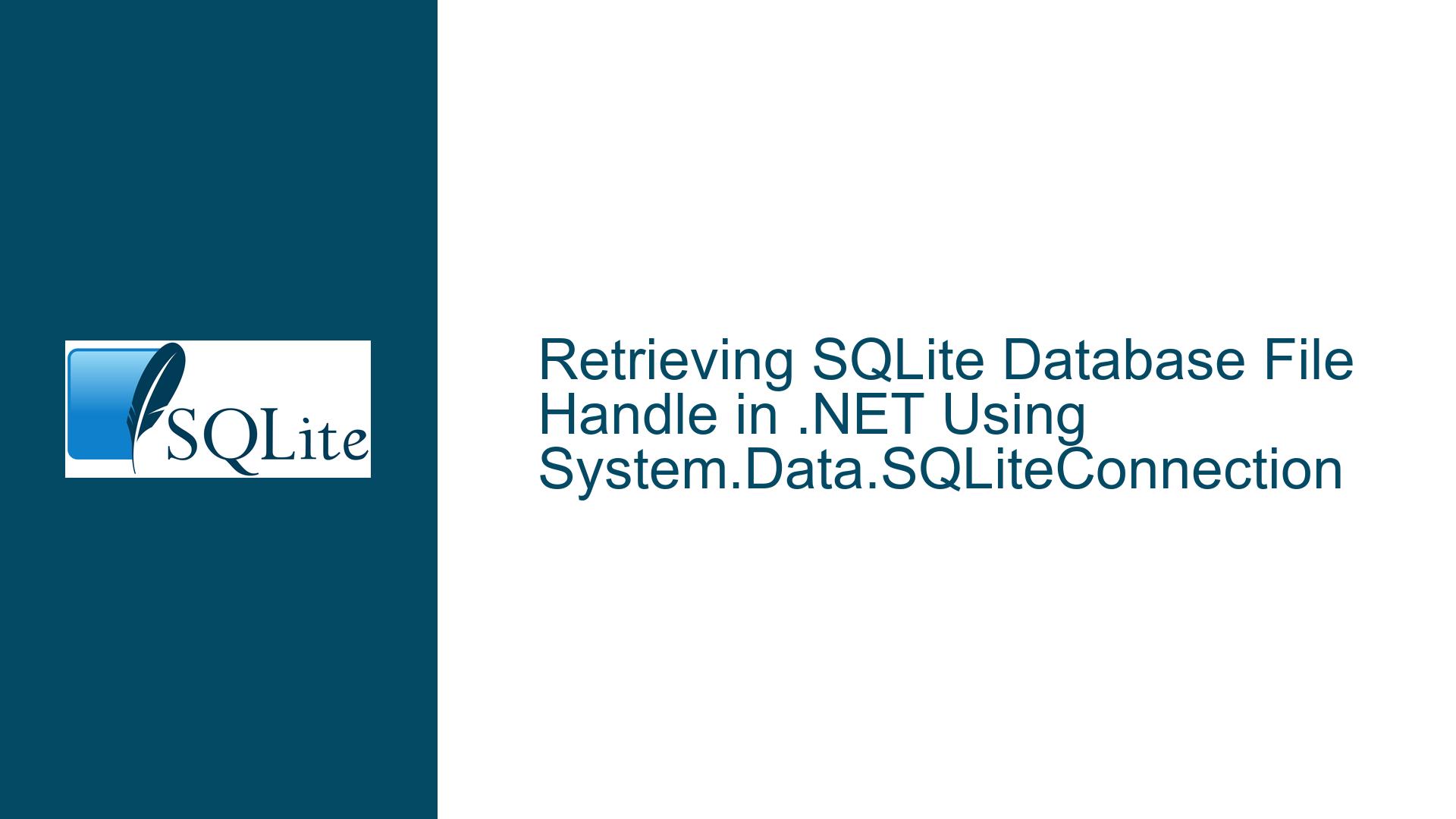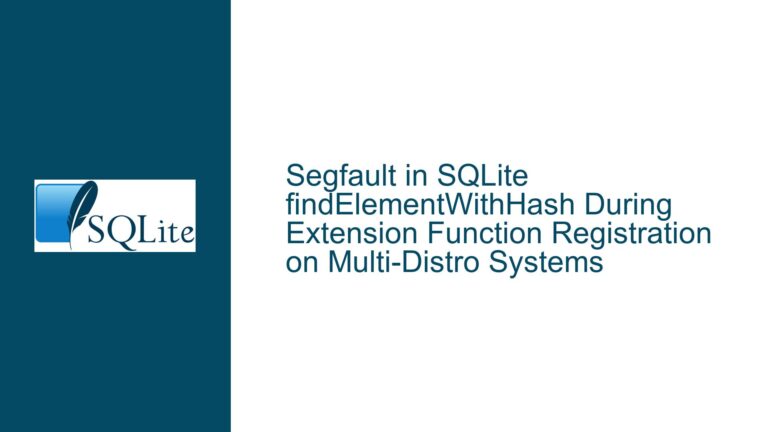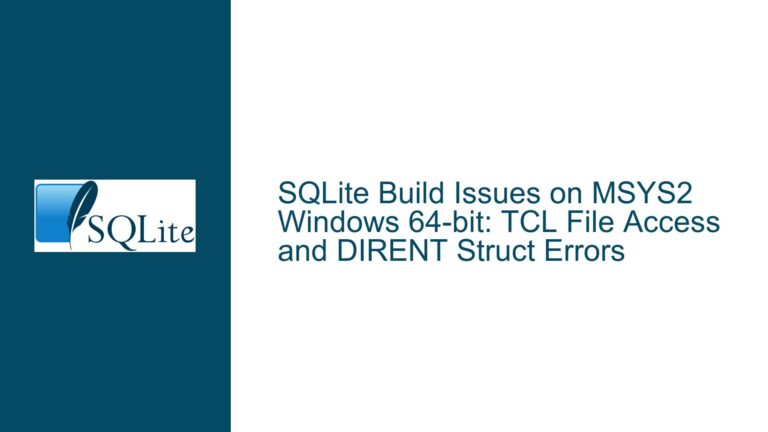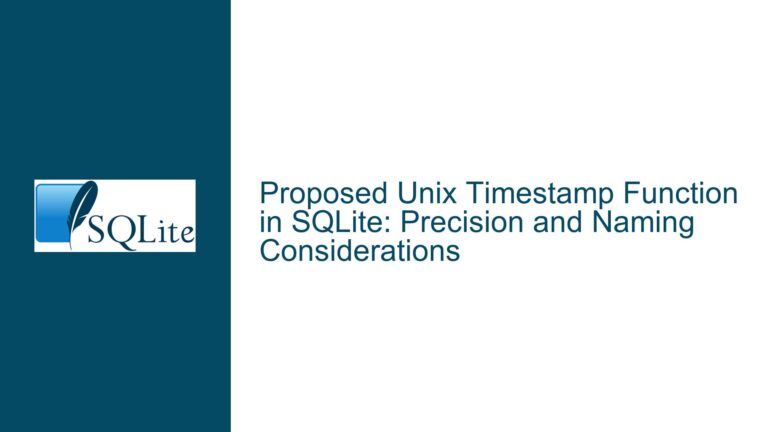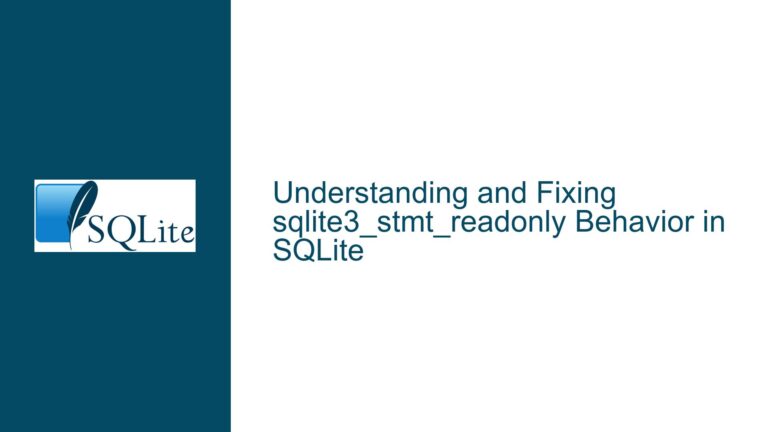Retrieving SQLite Database File Handle in .NET Using System.Data.SQLiteConnection
Accessing Native Database File Handle in System.Data.SQLiteConnection
When working with SQLite databases in a .NET environment, particularly using the System.Data.SQLiteConnection class, there are scenarios where direct access to the native database file handle or file descriptor is required. This need often arises when performing low-level operations on the database file, such as reading its contents directly from disk before closing the connection. The challenge lies in the fact that System.Data.SQLiteConnection abstracts away much of the native SQLite functionality, making it non-trivial to access the underlying file handle.
The primary goal is to retrieve the file handle of an already opened SQLite database file through the System.Data.SQLiteConnection object. This involves understanding how to interact with the native SQLite C API from within a .NET application, specifically using the sqlite3_file_control function and the SQLITE_FCNTL_WIN32_SET_HANDLE opcode. Additionally, the process may require interop with the SQLite.Interop.dll and reflection to extract the necessary handles from the managed SQLiteConnection object.
Understanding the Role of sqlite3_file_control and SQLITE_FCNTL_WIN32_SET_HANDLE
The sqlite3_file_control function is a part of the SQLite C API that allows for low-level control over the database file. It takes four parameters: a pointer to the database object (sqlite3*), the name of the database (as a byte array), an operation code (op), and a pointer to an argument (pArg). The SQLITE_FCNTL_WIN32_SET_HANDLE opcode is one of the operation codes that can be passed to sqlite3_file_control to manipulate the file handle associated with the database on Windows systems.
In the context of .NET, the System.Data.SQLite library provides a managed wrapper around the native SQLite library. However, it does not directly expose the sqlite3_file_control function or the SQLITE_FCNTL_WIN32_SET_HANDLE opcode. This necessitates the use of P/Invoke (Platform Invocation Services) to call the native function from managed code. The DllImport attribute is used to declare the external function, specifying the DLL name, calling convention, and function signature.
The function signature for sqlite3_file_control in C# would look like this:
[DllImport("SQLite.Interop.dll", CallingConvention = CallingConvention.Cdecl)]
internal static extern SQLiteErrorCode sqlite3_file_control(IntPtr db, byte[] zDbName, int op, IntPtr pArg);
Here, SQLiteErrorCode is an enumeration representing the possible return values from the SQLite C API, IntPtr is used to represent pointers in C#, and byte[] is used for the database name.
Extracting SQLiteConnectionHandle Using Reflection
To call sqlite3_file_control, you need a pointer to the native sqlite3 database object. This pointer is encapsulated within the SQLiteConnection object, but it is not directly accessible through the public API. This is where reflection comes into play. Reflection allows you to inspect and manipulate the internal state of objects at runtime, even if those members are private or internal.
The SQLiteConnection object contains a private field that holds the native database handle. By using reflection, you can access this field and retrieve the handle. The following code demonstrates how to use reflection to get the native database handle from a SQLiteConnection object:
using System.Data.SQLite;
using System.Reflection;
public IntPtr GetNativeHandle(SQLiteConnection connection)
{
FieldInfo fieldInfo = typeof(SQLiteConnection).GetField("_sql", BindingFlags.NonPublic | BindingFlags.Instance);
if (fieldInfo != null)
{
object sqlObject = fieldInfo.GetValue(connection);
if (sqlObject != null)
{
FieldInfo handleFieldInfo = sqlObject.GetType().GetField("_sql", BindingFlags.NonPublic | BindingFlags.Instance);
if (handleFieldInfo != null)
{
return (IntPtr)handleFieldInfo.GetValue(sqlObject);
}
}
}
throw new InvalidOperationException("Unable to retrieve native handle from SQLiteConnection.");
}
In this code, _sql is the name of the private field within the SQLiteConnection class that holds the native database handle. The BindingFlags.NonPublic and BindingFlags.Instance flags are used to access non-public instance members.
Combining Reflection and P/Invoke to Retrieve the File Handle
Once you have the native database handle, you can proceed to call sqlite3_file_control with the SQLITE_FCNTL_WIN32_SET_HANDLE opcode to retrieve the file handle. The following code demonstrates how to combine reflection and P/Invoke to achieve this:
using System;
using System.Data.SQLite;
using System.Reflection;
using System.Runtime.InteropServices;
public class SQLiteFileHandleRetriever
{
[DllImport("SQLite.Interop.dll", CallingConvention = CallingConvention.Cdecl)]
internal static extern SQLiteErrorCode sqlite3_file_control(IntPtr db, byte[] zDbName, int op, IntPtr pArg);
public IntPtr GetFileHandle(SQLiteConnection connection)
{
IntPtr nativeHandle = GetNativeHandle(connection);
if (nativeHandle == IntPtr.Zero)
{
throw new InvalidOperationException("Native handle is null.");
}
byte[] dbName = System.Text.Encoding.UTF8.GetBytes("main");
IntPtr fileHandle = IntPtr.Zero;
SQLiteErrorCode result = sqlite3_file_control(nativeHandle, dbName, (int)SQLiteFileControlOpcode.Win32SetHandle, fileHandle);
if (result != SQLiteErrorCode.Ok)
{
throw new SQLiteException($"Failed to retrieve file handle: {result}");
}
return fileHandle;
}
private IntPtr GetNativeHandle(SQLiteConnection connection)
{
FieldInfo fieldInfo = typeof(SQLiteConnection).GetField("_sql", BindingFlags.NonPublic | BindingFlags.Instance);
if (fieldInfo != null)
{
object sqlObject = fieldInfo.GetValue(connection);
if (sqlObject != null)
{
FieldInfo handleFieldInfo = sqlObject.GetType().GetField("_sql", BindingFlags.NonPublic | BindingFlags.Instance);
if (handleFieldInfo != null)
{
return (IntPtr)handleFieldInfo.GetValue(sqlObject);
}
}
}
throw new InvalidOperationException("Unable to retrieve native handle from SQLiteConnection.");
}
private enum SQLiteFileControlOpcode
{
Win32SetHandle = 0x7F001
}
}
In this code, SQLiteFileControlOpcode is an enumeration that defines the SQLITE_FCNTL_WIN32_SET_HANDLE opcode. The GetFileHandle method retrieves the native handle using reflection, then calls sqlite3_file_control to get the file handle. If the operation is successful, the file handle is returned; otherwise, an exception is thrown.
Handling Potential Issues and Edge Cases
While the above approach should work in most cases, there are several potential issues and edge cases to be aware of. First, the use of reflection to access private fields is inherently fragile, as changes to the internal structure of the SQLiteConnection class could break the code. This is particularly relevant if you are working with a different version of the System.Data.SQLite library than the one the code was written for.
Second, the SQLITE_FCNTL_WIN32_SET_HANDLE opcode is specific to Windows. If you are working on a different platform, such as Linux or macOS, this opcode will not be available, and you will need to use a different approach to retrieve the file handle. In such cases, you may need to use platform-specific APIs or file system calls to achieve the same result.
Third, the sqlite3_file_control function and the SQLITE_FCNTL_WIN32_SET_HANDLE opcode are not well-documented, and their behavior may vary between different versions of SQLite. It is important to test the code thoroughly on the target platform and with the specific version of SQLite you are using to ensure that it works as expected.
Finally, retrieving the file handle directly from the database connection can have implications for the stability and security of your application. If the file handle is used incorrectly, it could lead to data corruption or security vulnerabilities. It is important to handle the file handle with care and to ensure that it is used only for the intended purpose.
Alternative Approaches and Best Practices
Given the potential issues with using reflection and P/Invoke to retrieve the file handle, it is worth considering alternative approaches that may be more robust and maintainable. One such approach is to use the SQLite Backup API to create a backup of the database before closing the connection. This allows you to read the contents of the database without needing direct access to the file handle.
The SQLite Backup API provides a way to copy the contents of one database to another, either in memory or on disk. This can be done while the database is still open, allowing you to create a backup without interrupting normal operations. The following code demonstrates how to use the SQLite Backup API to create a backup of a database:
using System.Data.SQLite;
public void BackupDatabase(SQLiteConnection sourceConnection, string destinationPath)
{
using (SQLiteConnection destinationConnection = new SQLiteConnection($"Data Source={destinationPath};Version=3;"))
{
destinationConnection.Open();
using (SQLiteTransaction destinationTransaction = destinationConnection.BeginTransaction())
{
sourceConnection.BackupDatabase(destinationConnection, "main", "main", -1, null, 0);
destinationTransaction.Commit();
}
}
}
In this code, the BackupDatabase method creates a backup of the database connected to sourceConnection and saves it to the specified destinationPath. The backup is performed within a transaction to ensure consistency.
Another alternative is to use the SQLite VFS (Virtual File System) API to intercept file operations and gain access to the file handle. This approach is more complex and requires a deeper understanding of the SQLite internals, but it provides greater flexibility and control over how the database file is accessed.
Conclusion
Retrieving the native database file handle from a System.Data.SQLiteConnection object in a .NET application is a complex task that requires a deep understanding of both the SQLite C API and the .NET framework. By combining reflection and P/Invoke, it is possible to access the underlying file handle and perform low-level operations on the database file. However, this approach is not without its challenges and potential pitfalls, and it is important to consider alternative approaches that may be more robust and maintainable.
When working with SQLite in a .NET environment, it is always a good idea to leverage the higher-level abstractions provided by the System.Data.SQLite library whenever possible. These abstractions are designed to simplify common tasks and reduce the risk of errors. However, when low-level access is required, the techniques described in this guide can be used to achieve the desired results.
Ultimately, the choice of approach will depend on the specific requirements of your application and the constraints of the environment in which it is running. By carefully considering the trade-offs and testing thoroughly, you can ensure that your application interacts with SQLite in a way that is both effective and reliable.
